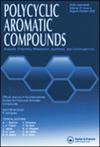新型 1,2,4-三唑硫醇-噻吩杂化物:简易合成、表征、ADMET 预测和分子对接
IF 2.4
3区 化学
Q2 CHEMISTRY, ORGANIC
引用次数: 0
摘要
在本研究成果中,新型 1,2,4-三唑硫醇-噻吩混合物,即 4-乙基-5-(噻吩-2-基)-4H-1,2,4-三唑-3-硫醇 (1) 和 4-苯基-5-(噻吩-2-基)-4H-1,2,4-三唑-3-硫醇 (2)、这两种化合物分别是在噻吩-2-甲酰肼中加入异硫氰基乙烷或异硫氰基苯,然后加入 KOH 溶液使其环化生成 1,2,4-三唑环而制成的。化合物 1 和 2 的形成通过元素分析、红外光谱、1H 和 13C{1H} NMR 光谱得到了证实。NMR 光谱。此外,还应用了基于 DFT 的气相计算来揭示标题化合物的结构和电子特征。理论计算显示,这两种分子的相应硫酮衍生物,即 4-乙基-5-(噻吩-2-基)-2,4-二氢-3H-1,2,4-三唑-3-硫酮(1')和 4-苯基-5-(噻吩-2-基)-2,4-二氢-3H-1,2,4-三唑-3-硫酮(2'),在气相中的能量分别为 15.00 千卡/摩尔和 11.96 千卡/摩尔。不过,通过比较实验和计算得出的红外光谱和核磁共振光谱,可以证明化合物 1 和 2 在固态和 DMSO-d6 中都是硫醇同系物。1 和 2 的化学活性是通过反应性描述符和 MEP 表面进行估算的。利用在线服务对所报告化合物的 ADMET 特性进行了硅预测。利用分子对接技术研究了化合物 1 和 2 对一系列蜱传脑炎(TBE)蛋白的潜在抑制作用,进而揭示了由此产生的蛋白配体复合物的配体效率得分。结果表明,化合物 1 对蜱传脑炎病毒丝氨酸蛋白酶 NS3 的活性最好,而化合物 2 对蜱传脑炎病毒螺旋酶的 RNA 刺激 ATPase 活性更有利。本文章由计算机程序翻译,如有差异,请以英文原文为准。
Novel 1,2,4-triazolethiol–thiophen Hybrids: Facile Synthesis, Characterization, ADMET Prediction and Molecular Docking
In the present contribution, novel 1,2,4-triazolethiol–thiophene hybrids, namely 4-ethyl-5-(thiophen-2-yl)-4H-1,2,4-triazole-3-thiol (1) and 4-phenyl-5-(thiophen-2-yl)-4H-1,2,4-triazole-3-thiol (2), which were readily fabricated from addition of isothiocyanatoethane or isothiocyanatobenzene, respectively, to thiophene-2-carbohydrazide followed by addition a KOH solution to provoke the cyclization to the 1,2,4-triazole ring. The formation of compounds 1 and 2 was firmly confirmed by the means of elemental analysis, IR, 1H and 13C{1H} NMR spectroscopy. The DFT-based computations in gas phase were additionally applied to shed light on the structure and electronic features of the title compounds. Theoretical calculations revealed that for both molecules their corresponding thione derivatives, namely 4-ethyl-5-(thiophen-2-yl)-2,4-dihydro-3H-1,2,4-triazole-3-thione (1') and 4-phenyl-5-(thiophen-2-yl)-2,4-dihydro-3H-1,2,4-triazole-3-thione (2'), are 15.00 and 11.96 kcal/mol, respectively, more energetically favorable in gas phase. However, a comparison of the experimental and calculated IR and NMR spectra testify to the thiol tautomers of compounds 1 and 2 for both compounds in solid state and in DMSO-d6. The chemical activity of 1 and 2 was estimated by reactivity descriptors and MEP surface. ADMET properties of the reported compounds were predicted in silico using online services. Potential inhibition of a series of the tick-borne encephalitis (TBE) proteins by compounds 1 and 2 was studied using molecular docking, which, in turn, allowed to reveal the ligand efficiency scores for the resulting protein–ligand complexes. It was established that compound 1 exhibits the best activity against the tick-borne encephalitis virus Serine protease NS3, while compound 2 is preferable for the RNA-stimulated ATPase activity of tick-borne encephalitis virus helicase.
求助全文
通过发布文献求助,成功后即可免费获取论文全文。
去求助
来源期刊

Polycyclic Aromatic Compounds
化学-有机化学
CiteScore
3.70
自引率
20.80%
发文量
412
审稿时长
3 months
期刊介绍:
The purpose of Polycyclic Aromatic Compounds is to provide an international and interdisciplinary forum for all aspects of research related to polycyclic aromatic compounds (PAC). Topics range from fundamental research in chemistry (including synthetic and theoretical chemistry) and physics (including astrophysics), as well as thermodynamics, spectroscopy, analytical methods, and biology to applied studies in environmental science, biochemistry, toxicology, and industry. Polycyclic Aromatic Compounds has an outstanding Editorial Board and offers a rapid and efficient peer review process, as well as a flexible open access policy.
 求助内容:
求助内容: 应助结果提醒方式:
应助结果提醒方式:


